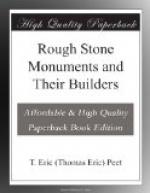In the Jaulan, where the rock consists of a slabby type of basalt, there are many dolmens of fine appearance. They often lie east and west, and are often broader at the west end. Many are surrounded by a double circle of stones. In one of them two copper rings were found. At Ain Dakkar more than 160 dolmen-tombs are visible from a single spot. They are built on circular terraces of earth and stones about 3 feet high. The Arabs call them Graves of the Children of Israel. Most of them lie east and west, and are broader at the west. In the eastern slab there is often a hole about 2 feet in diameter. Near Tsil are several corridor-tombs of simple type. Each consists of a long rectangular chamber with only one cover-slab, that being at the west end. In a well-known example of this type at Kosseir there is a hole in one of the two uprights which support the cover.
These examples will serve to show the importance and variety of the Syrian monuments. They present analogies with those of many parts of the megalithic area, and we therefore await anxiously the publication of Mackenzie’s promised article on his own explorations in this district.
The central and southern parts of India afford numerous examples of dolmens. They are to be found in almost all parts of Lower India from the Nerbudda River to Cape Comorin. In the Nilgiri hills there are stone circles and dolmens, and numbers of dolmens are said to exist in the Neermul jungle in Central India. In the collectorate of Bellary dolmens and other monuments to the number of 2129 have been recorded. Others occur in the principality of Sorapoor and near Vellore in the Madras presidency. These latter appear to be of two types, either with three supports only or with four supports, one of which is pierced with a circular hole. Of the 2200 dolmens known in the Deccan, half are of this pierced type. They are known to the natives as “dwarfs’ houses.” One only had a pair of uprights outside the pierced stone, thus forming a sort of portico to the dolmen. Near Chittore in North Arcot there is said to be a square mile of ground covered with these monuments. In them were found human remains in sarcophagi, and fragments of black pottery. Several of the Indian dolmens are said to have contained objects of iron. Occasionally the dolmen is surrounded by a double circle of stones or covered with a cairn. The Deccan, in addition to its numerous dolmens, possesses also megalithic monuments of another type. They consist each of two rows, each of thirteen unworked stones set as close together as possible, in front of which is a row of three stones, each about 4 feet high, not let into the ground. The planted stones were whitewashed, and each was marked with a large spot of red paint with black in the centre. These stones seem to have been in use in modern times. Colonel Forbes Leslie thinks that a cock had been sacrificed on one of the three stones which lie in front of the double row, but there seems to be no certain evidence for this. It is, however, very probable that these alignements had some religious signification, and the same is no doubt true of certain small circles of small stones, also found in the Deccan.




